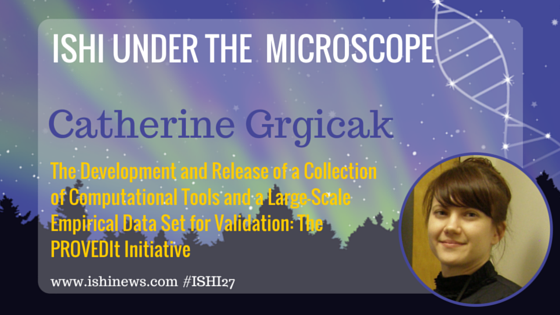The ISHI27 agenda is already filling up with some great talks from amazing speakers! While the forensic community is a tight-knit group, we can always get a little closer, right? With that in mind, we asked our speakers some questions to get to know them a little better outside of their work. We’ve been posting their responses in a feature we like to call Under the Microscope.
Today, we’re chatting with Catherine Grgicak, who will be presenting at the Validation and Mixture Interpretation Standard Operating Procedures workshop on Monday, September 26th and The Development and Release of a Collection of Computational Tools and a Large-Scale Empirical Data Set for Validation: the PROVEDIt Initiative during the General Sessions on Tuesday, September 27th.
Dr. Catherine Grgicak (Gerg-i-chuck) is an Assistant Professor in the Biomedical Forensic Sciences Program at Boston University’s School of Medicine. She received her Bachelor of Science in Physical Sciences and Bachelor of Education from the University of Windsor, in Ontario Canada. She then went on to attain her Masters of Science in Forensic Sciences from the University of Alabama at Birmingham and Ph.D. in Chemistry from the University of Ottawa in Ontario Canada. She currently teaches courses in forensic DNA analysis and forensic chemistry. Her forensic operations experience was obtained at the Alabama Department of Forensic Sciences in the CODIS unit and at Cellmark Diagnostics in Germantown MD. She is Executive Secretary of the OSAC subcommittee on Biological Data Interpretation and Reporting and is on the Editorial Board of the Journal of Forensic Sciences. Her current research focusses on nucleic acid and electrochemical analysis and interpretation of noisy signal from samples originating from complex environments.
How did you come to work in the field of forensics/DNA?
I had just completed my undergraduate education and was interested in continuing my education. A colleague and mentor suggested I look into forensic science programs. I did as she suggested, and ended up enrolling in the M.S.F.S. program at UAB.
What is your favorite thing about your job? Why?
I enjoy the challenge associated with determining and then implementing methods and procedures that simplify the signal obtained from samples originating from complex environments.
What is the biggest challenge you face in your job?
The biggest challenge is the implementation of cost effective, reasonable and utilitarian methods in the laboratory.
What accomplishment are you most proud of relating to forensics/DNA?
Being part of a team of interdisciplinary scientists, statisticians and engineers who care about the challenges faced by forensic scientists and who support the publication of our work and data through.
If you’ve attended ISHI before, what keeps you coming back? If you’ve never attended before, what are you most looking forward to at ISHI27?
I enjoy the posters. I always find myself interested in a great many of them and believe that ISHI provides a good forum to speak with researchers interested in the same issues.
When you were little, what career did you think you’d have as an adult?
Archaeologist.
Where do you see the future of forensic science headed?
I do not want to even venture a guess. The problems forensic scientists face are complex and require detailed analysis and clever solutions. Solutions that originate from tackling such problems will, I suspect, bring about significant advances.
What do you hope the audience learns/takes away from your talk?
That openness in research and data sharing has the capability of significantly improving forensic research, validation and operations.
What person would you say has had the biggest influence in your career?
Georgia “Sue” Rogers & Robin W. Cotton in forensics and Javier B. Giorgi in chemistry. My students have also taught me a lot about myself as a person and teacher.
If you could time-travel, what year would you go to and why?
I am a person who strives to live in the present at all times.
Star Wars or Star Trek?
Lord of the Rings 😉
WOULD YOU LIKE TO SEE MORE ARTICLES LIKE THIS? SUBSCRIBE TO THE ISHI BLOG BELOW!


